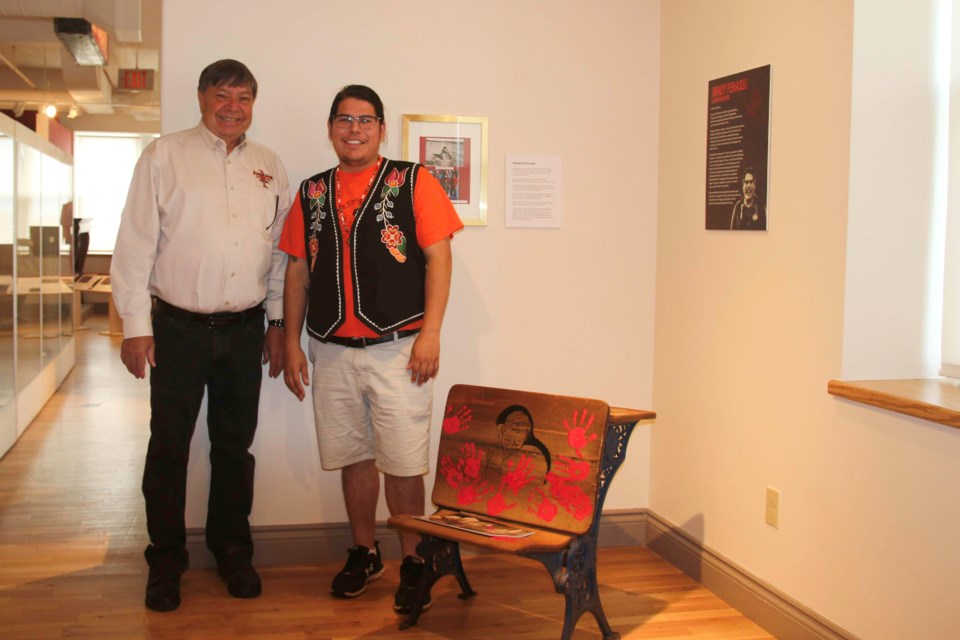The “Residential Desk Project” exhibit opened today at the North Bay Museum and will run until September. Local wildlife photographer Les Couchi developed the exhibit along with Joan McLeod. Together, they approached Keith Campbell, Sean and Alexandra Couchie, Donald Chretien, Bray Penasse, Paulette Chretien, and Tracy LaRochelle to contribute works to the display.
All eagerly agreed to participate.
See: Antique school desks part of residential school museum display
The focal points of the show are small children’s desks, antique, very similar to the ones used by residential school students. These small desks remind the viewer “how small and innocent these children were when they were separated from their families,” organizers said.
Rounding out the exhibit are various artworks by local residential school survivors. June Commanda is one of those survivors, and she helped to open the exhibit this morning by delivering a prayer to the audience of around 60 people.
Commanda, born in Garden Village, mentioned that she was in residential school – along with her sister and brother – for five years. Her mother was within residential school for ten years. She noted that of the 127 survivors from the area, “there are eight of us left.”
“And I am thankful to stand here and say that I’m a survivor, because many didn’t, and many didn’t find their way back to Nipissing who belonged here.”
See: Ontario Northland unveils Every Child Matters locomotive
Many Nbisiing (Nipissing) children were enrolled by an Indian Agent to the residential schools in Spanish, a small town East of Massey on Highway 17. It’s about two and a half hours from Nipissing First Nation. The boys went to St. Peter Claver School. The Jesuits owned and operated that. The girls went to St. Joseph’s, operated by the Daughters of the Heart of Mary.
The schools opened in 1913 and closed in 1962. While open, the goal was to destroy the child’s culture and language and colonize the child so as to eradicate the “Indian problem,” and the younger the kid, the more likely this could happen, according to Nicholas F. Davin, who’s Report on Industrial Schools for Indians and Half-Breeds from 1879 strongly recommended the implementation of residential schools in Canada.
Children were assigned numbers, and that’s what they answered to. Their names were never used.
Artists Sean and Alexandra Couchie –a father daughter collaboration – created a double desk emblazoned with painted monarch butterflies. Both wanted to choose something “delicate, to represent the souls and the spirits of the kids, who were so small when they were taken away from their families.”
The butterfly also represents change and transformation, and the two thought it made a perfect symbol due to how these schools created such a sea change within First Nations’ communities, families, and within the individual.
“The paths that they may have taken, changed at that moment,” Sean said. “Some were able to come out as survivors, and actually blossom, some did not.”
“And that’s what the shadows of the butterflies represent. The ones who were never able to come home.”
Another artist displaying, Brady Penasse, mentioned his grandfather, Howard Penasse, was in residential school, and creating the work was at times difficult for him. “It was very emotionally draining,” he said, as he usually tries to evoke “beauty and positivity” with his art.
“It’s hard to go to that dark place,” he said. But he did. He thought about how often kids will carve into or draw upon school desks. He took that image and imagined what his grandfather’s desk would look like if he had a chance to personalize it. He added an image of a Thunderbird, and many phrases in Nishnaabemwin, the language the school worked to make him forget, or be ashamed of.
Carved into the desk in both English and Nishnaabemwin is “Howard was Here,” to commemorate his grandfather’s time at residential school. A series of red handprints further accentuate the desk, courtesy of his little niece, Ziigwan, “who has the smallest hands in the family.”
Her prints “in a sense, help to connect us all.”
David Briggs is a Local Journalism Initiative reporter who works out of BayToday, a publication of Village Media. The Local Journalism Initiative is funded by the Government of Canada.



